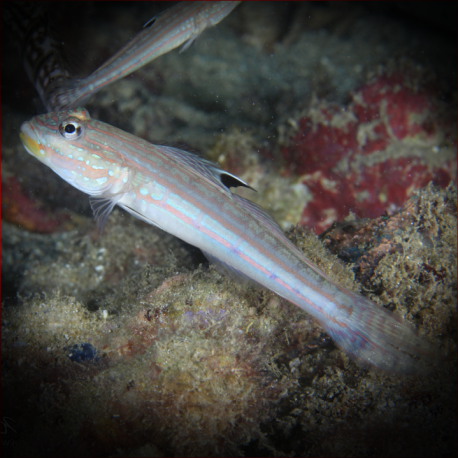More info
Datasheet
| Minimum Tank Size | 400 litres / 105.67 US gallons |
| Maximum Size | 16.0cm / 6.30inches |
| Reef Compatible | Reef safe with caution |
| Temperament | Mostly peaceful but might be aggressive towards similar species |
| Temperature | 22.2°C / 71.96°F - 25.6°C / 78.08°F |
| Specific Gravity | 1.020-1.025 |
| Carbonate Hardness | 8-12 |
| pH | 8.1-8.4 |
General Description
The Valenciennea muralis, commonly known as the Mural goby, is a member of the Gobiidae family. These small fish are native to the Indo-West Pacific region, particularly found in the eastern Indian Ocean and the western tropical Pacific. They belong to the Valenciennea genus and are known for their striking striped appearance.
Aquarium Suitability
The Mural goby is recommended for experienced aquarists due to their specific care requirements. They demand special preparation and extra care, requiring a well-established aquarium with a sufficient population of microorganisms like copepods and amphipods for continuous feeding. These gobies do best in pairs, consisting of a male and a female.
Care and Hardiness
With average hardiness, Mural gobies prefer a stable environment with water parameters set at a pH of 8.1-8.4, a temperature range of 22.2-25.6°C, and a salinity level of 1.020-1.025. They are initially shy but become more comfortable with time, although they may rearrange the aquarium sand, potentially burying corals. The fish can also be aggressive towards similar species and require ample hiding spots among live rocks.
Reef Suitability
Considered reef safe with caution, Mural gobies can be kept in reef aquariums if monitored closely due to their habit of rearranging sand, which can affect corals. They are generally peaceful but may exhibit aggression towards their own kind or similar species.
Aquarium Setup
For optimal care, a tank size of at least 400 liters is recommended to accommodate a pair of Mural gobies. The setup should include live rocks for hiding, as well as a sandy substrate that the fish can filter food from. However, it is essential to ensure that the rock structures are secure to prevent collapses caused by sand movement.
Behaviour
Mural gobies are known to be mostly peaceful but can display territorial behavior towards conspecifics. They might engage in sand sifting behavior as they search for food, potentially spreading sand across the tank. Additionally, these gobies have a tendency to jump out of open aquariums, so a secure lid is essential.
Feeding and Diet
These fish are carnivorous, primarily consuming small crustaceans like krill, mysis, and artemia. They also feed on zooplankton such as Cyclops and pods. Mural gobies require frequent feeding, ideally four or more times a day, to ensure they remain healthy and vibrant.
Dimorphism
Mural gobies exhibit sexual dimorphism, with differences in coloration and size between males and females. In a suitable environment, these gobies can reproduce in captivity, adding to their appeal for dedicated aquarists.
Habitat and Distribution
In their natural habitat, Mural gobies are widely distributed across the East Indian Ocean, West Indian Ocean, Australia, Japan, Indonesia, and the Central/West Pacific. They are commonly found in sandy substrates and prefer living close to the ocean floor, sifting through sand for food.

